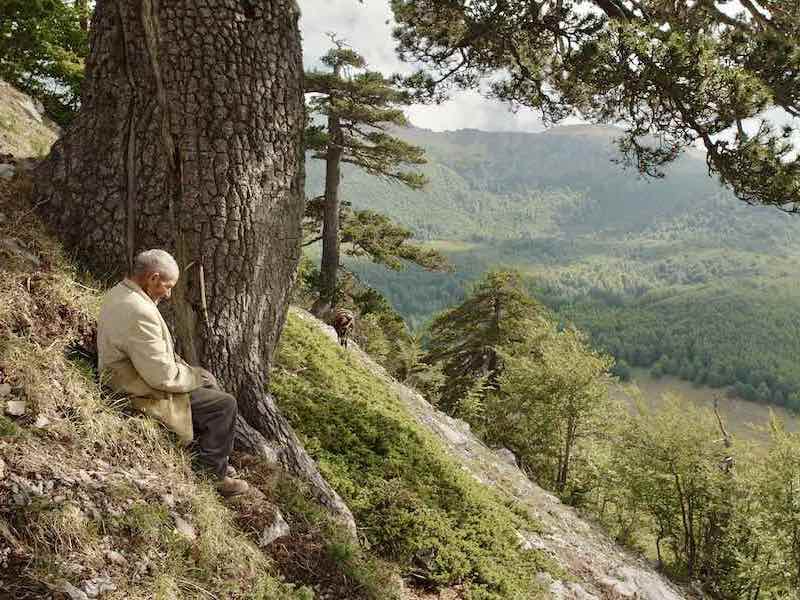
Italy, 1961. While in the prosperous north of the country Europe’s tallest building is being erected, a group of adventurers in untouched Calabria is plunging into the depths. The young speleologists are exploring Europe’s deepest cave, the Abisso di Bifurto, reaching the bottom ground for the first time. This bold undertaking goes unnoticed by the inhabitants of the nearby village, but not by the old shepherd of the Pollino plateau, whose life becomes intertwined with the endeavour.
EN
As seen by Frammartino, the young explorers’ enterprise morphs into a kind of colonization, an offshoot of the economic miracle to which the expedition sought to offer a kind of alternative: a move away from the flashy consumerism of those years toward a more archaic voyage through time and space. All the mapping, studying, and classifying—noble as their intent may be—still amount to an invasion, a desecration of a holy ground that yanks the cave out of the realm of myths and gives it a name, a depth, and a limit. It’s a piercing rumination brimming with riveting images: newspaper scraps burnt and thrown into the cave, the embers billowing gently down the abyss; the abyss itself, a sweaty, claustrophobic maze; and then again the mist-shrouded mountaintops outside, gracing the film with a sudden expanse. Contemplative and mystical, Il buco doesn’t just invite you to witness the unfurling of a secret world—it teaches a new way of seeing.
Leonardo Goi1
Michelangelo Frammartino: If you’re an independent filmmaker you know your camera will always, to some degree, carry violence. It’s a military instrument; you cannot forget that, ever. The youngsters who chose to sneak their way underground in 1961 were extraordinary, bold, daring; they went against the prevailing forces of their era, and worked “for free” for the rest of us, in a way. But they were also unmistakably involved in a kind of colonization, as you say: they gave a shape to an erstwhile unshaped world. The minute they started mapping the contours of that cave they stripped it of all its myths.
Leonardo Goi: They gave it a limit.
Frammartino: A limit and a shape. They christened it. Now you know it’s a cave with twenty-nine pits. Nothing is left to the imagination. The saddest, most violent thing is when a cave turns into a tourist destination. That’s when you know it’s all over. I guess what I’m saying is that even as you chronicle an expedition as formidable as this, you’re always going to face a darker reverse-shot.
Michelangelo Frammartino in conversation with Leonardo Goi2
“There’s a way of watching Il Buco that may take a little time to attune to, in the same way you might have to while watching a Jacques Tati movie. It’s a question of image navigation: Frammartino shoots mainly in long shots and the manner in which you take the story in is, as above, a bit of a game. You must first work out where your attention is supposed to be focused, and then if you do follow your instincts, you must then calculate whether you are missing out on details elsewhere. There might be a clue, like a dim flicker of light in the middle distance, or some rumbling sounds emanating from a certain area off-screen. But each shot needs to be unlocked.
On that note: filmmakers vocally pleading with audiences to see movies in the cinema – or the biggest screen available to them – is currently in vogue despite valid protestations regarding accessibility. One hopes that Frammartino joins the chorus, as it genuinely seems as if he has made a film which only functions in its intended way by being experienced in the enclosed, sensory-deprived environs of a pitch black and completely silent cinema. And one with a top spec sound system for that matter.”
David Jenkins3
- 1Leonardo Goi, “Venice Dispatch: Schrader’s ‘The Card Counter,’ Villeneuve’s ‘Dune,’ and Frammartino’s ‘Il buco’,” 4 September 2021.
- 2Leonardo Goi, “Into the Abyss: Michelangelo Frammartino on ‘Il buco’,” 13 May 2022.
- 3David Jenkins, “Il Buco first-look review,” 4 September 2021.

